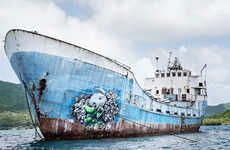
These Stunning Photos From Chernobyl are Taken 28 Years Later
Jennifer Paul — April 28, 2014 — Art & Design
A terrible incident happened in Chernobyl in April 1986 when the nuclear reactor melted. This resulted in an explosion and fires that were extremely hard to tame. There were also large amounts of radioactive particles in the air. People lost their lives, their homes and their personal belongings.
The incident was the worst nuclear power plant accident in history when you think about the cost and number of deaths. These chilling photos really put it into perspective. You can see the amount of gas masks and personal belongings left behind. The city looks completely deserted with an eerie feeling to every photo.
The area was originally 30 km in all directions from the plant, but is now called the 'zone of alienation' except for the 300 or so inhabitants that refuse to leave.
The incident was the worst nuclear power plant accident in history when you think about the cost and number of deaths. These chilling photos really put it into perspective. You can see the amount of gas masks and personal belongings left behind. The city looks completely deserted with an eerie feeling to every photo.
The area was originally 30 km in all directions from the plant, but is now called the 'zone of alienation' except for the 300 or so inhabitants that refuse to leave.
Trend Themes
1. Urban Exploration - Opportunity for photographers and adventure seekers to capture and document abandoned and restricted areas, such as the Chernobyl exclusion zone.
2. Environmental Remediation - Potential for companies and experts to develop innovative solutions for cleaning and restoring areas contaminated by radioactive substances.
3. Disaster Tourism - Emerging trend of travelers visiting disaster-stricken locations for educational and experiential purposes, creating opportunities for local tourism industries.
Industry Implications
1. Photography - Photographers can specialize in capturing unique and evocative images of abandoned and hazardous locations, offering their services to publications and agencies.
2. Environmental Engineering - Engineers and professionals in this field can contribute to the development of new technologies and methods for decontaminating and rehabilitating polluted areas.
3. Travel and Tourism - Tour operators and travel agencies can cater to the growing demand for visiting disaster sites, offering guided trips and educational experiences around affected areas.
6.6
Score
Popularity
Activity
Freshness























